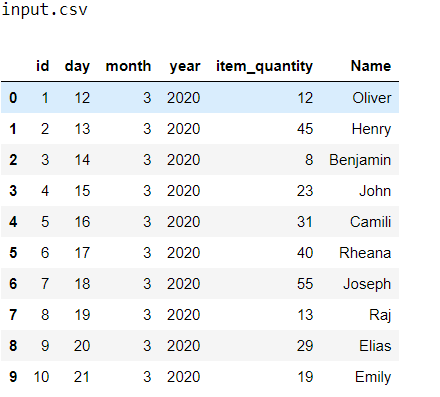Delete a CSV Column in Python
Last Updated :
02 Feb, 2021
The comma-separated values (CSV) file is a delimited text file that uses commas for individual values. Each line of the file is a data record in CSV. This format used for tabular data, rows, and columns, exactly like a spreadsheet. The CSV file stores data in rows and the values in each row are separated with a comma(separator), also known as a delimiter.
There are 2 ways to remove a column entirely from a CSV in python. Let us now focus on the techniques :
- With pandas library — drop() or pop()
- Without pandas library
Here, a simple CSV file is used i.e; input.csv
| id | day | month | year | item_quantity | Name |
| 1 | 12 | 3 | 2020 | 12 | Oliver |
| 2 | 13 | 3 | 2020 | 45 | Henry |
| 3 | 14 | 3 | 2020 | 8 | Benjamin |
| 4 | 15 | 3 | 2020 | 23 | John |
| 5 | 16 | 3 | 2020 | 31 | Camili |
| 6 | 17 | 3 | 2020 | 40 | Rheana |
| 7 | 18 | 3 | 2020 | 55 | Joseph |
| 8 | 19 | 3 | 2020 | 13 | Raj |
| 9 | 20 | 3 | 2020 | 29 | Elias |
| 10 | 21 | 3 | 2020 | 19 | Emily |
Method 1: Using pandas library
Python is a great language for doing data analysis, primarily because of the fantastic ecosystem of data-centric python packages. Pandas is one of those packages and makes importing and analyzing data much easier. Pandas consist of a drop function that is used in removing rows or columns from the CSV files. Pandas Pop() method is common in most of the data structures but the pop() method is a little different from the rest. In a stack, pop doesn’t require any parameters, it pops the last element every time. But the pandas pop method can take input of a column from a data frame and pop that directly.
Example 1: Using drop()
data.drop( labels=None, axis=0, index=None, columns=None, level=None, inplace=False,errors='raise')
- Import Pandas
- Read CSV File
- Use drop() function for removing or deleting rows or columns from the CSV files
- Print Data
Python3
import pandas as pd
data = pd.read_csv('input.csv')
print("Original 'input.csv' CSV Data: \n")
print(data)
data.drop('year', inplace=True, axis=1)
print("\nCSV Data after deleting the column 'year':\n")
print(data)
|
Output:

Example 2: Using pop()
We can use the panda pop () method to remove columns from CSV by naming the column as an argument.

- Import Pandas
- Read CSV File
- Use pop() function for removing or deleting rows or columns from the CSV files
- Print Data
Python3
import pandas as pd
data = pd.read_csv('input.csv')
print("Original 'input.csv' CSV Data: \n")
print(data)
data.pop('year')
print("\nCSV Data after deleting the column 'year':\n")
print(data)
|
Output:

Method 2: Using CSV library
Example 3: Using CSV read and write
- Open Input CSV file as source
- Read Source CSV File
- Open Output CSV File as a result
- Put source CSV data in result CSV using indexes
Python3
import csv
with open("input.csv", "r") as source:
reader = csv.reader(source)
with open("output.csv", "w") as result:
writer = csv.writer(result)
for r in reader:
writer.writerow((r[0], r[1], r[2], r[4], r[5]))
|
Output:


Like Article
Suggest improvement
Share your thoughts in the comments
Please Login to comment...